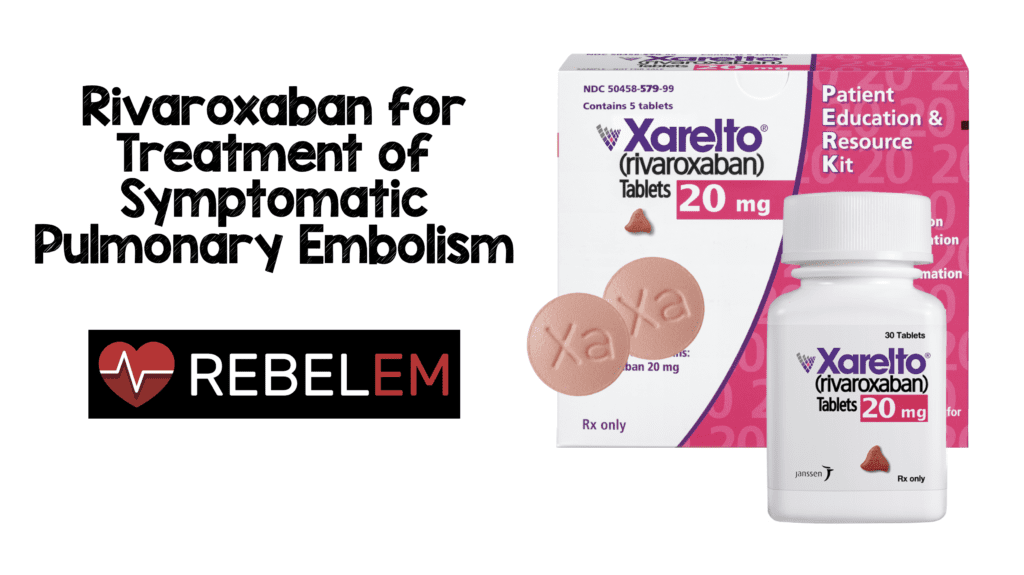

Lets start with a case:
A 37 y/o male presents to the ED with CC of dyspnea and pleuritic chest pain. 2 weeks earlier he was on a 13 hour flight and doing well. 4 days before presentation he began to have some pleuritic right sided chest pain with dyspnea. He felt like he was having fevers and diaphoretic as well. He has no past medical history, no past surgical history, no allergies to medications and not taking any medications, does not smoke, and drinks socially.
VS: BP 136/83 HR 99 (His baseline is in the 50’s – 60’s) RR 20 Temp 99.8 O2 Sat 94% on RA
He appears diaphoretic and really no other abnormalities on his physical exam including no extremity swelling
His ECG is NSR, with normal axis, and no evidence of right heart strain
CXR is shown below
Labs were unremarkable including no elevation in BNP, Cardiac Enzymes, and interestingly had an ELISA D-Dimer of 390
He is ultimately diagnosed with bilateral sub segmental PEs with a right sided pulmonary infarct.

After discussion with the patient it is decided that the patient wants to be treated as an outpatient and not be admitted. You tell him that you are going to start him on enoxaparin and warfarin. You explain to him that enoxaparin injections will be twice a day and that the syringes need to be refrigerated, and that he will require PT/INR checks weekly. He states that he travels quite a bit and actually leaving in two days for a conference and would not be able to make the PT/INR checks and that it would not be feasible to take a cooler of enoxaparin syringes onto an airplane. How do we treat this patient now?
You remember reading a recent article that talked about one of the new Xa inhibitors being used for treatment of PEs that did not require refrigeration, injections, or PT/INR checks and go to look it up.
Oral Rivaroxaban for Treatment of Symptomatic Pulmonary Embolism (EINSTEIN-PE Trial) [1]
What they did:
- Randomized, open-label non-ineriority trial at 263 sites in 38 countries
- 4832 patients with acute symptomatic pulmonary embolism with or without DVT
- Rivaroxaban Arm 2,419 patients
- Standard Therapy Arm 2,413 patients
- Comparison of oral rivaroxaban (15mg BID for 3 weeks, followed by 20mg qday) vs standard therapy with enoxaparin followed by an adjusted dose vitamin K antagonist for 3, 6, or 12 months
Primary Outcomes:
- Efficacy: Symptomatic recurrent venous thromboembolism (VTE)
- Safety: Major or clinically relevant non-major bleeding
Exclusion Criteria:
- Creatinine clearance < 30 mL/min
- Clinically significant liver disease (i.e. Acute hepatitis, chronic active hepatitis, or cirrhosis)
- ALT greater than 3x upper limit of normal
- Bacterial endocarditis
- Active bleeding or high risk of bleeding
- SBP > 180 mmHg or DBP > 110 mmHg
- Childbearing with out proper contraceptive measures, pregnancy, or breast feeding
- Use of strong inhibitor of P450 CYP3A4 medications (i.e. protease inhibitors, ketoconazole) or P450 CYP3A4 inducer medications (i.e. rifampin, carbamazepine, or phenytoin)
- Life expectancy < 3 months
Results:
- Efficacy: Rivaroxaban 50 recurrent VTEs (2.1%) vs standard therapy 44 recurrent VTEs (1.8%)
- Safety: Rivaroxaban 10.3% vs standard therapy 11.4% (p value = 0.23)
- Major Bleeding: Rivaroxaban 26 events (1.1%) vs standard therapy 52 events (2.2%) (p value = 0.003)
- Median duration of enoxaparin in standard therapy group was 8 days (Range 6 – 11 days)
- Recurrent VTE rivaroxaban vs standard therapy: Subsegmental PEs (1.6% vs 1.3%), Intermediate PEs (2.5% vs 2.2%), and Extensive PEs (1.5% vs 1.4%)
Limitations:
- Trial was funded by Janssen Pharmaceuticals who is the maker of rivaroxaban (Xarelto)
- Not really a limitation, but should be stated, small percentage of patients lost to follow up in both arms: Rivaroxaban 8 patients (0.3%) vs standard therapy 10 patients (0.4%)
- Non-inferiority design may make it difficult to detect small differences in treatment arms
- Open-label design may have biased patients and investigators
- Younger patient population with a mean age of 58 may make it difficult to generalize this to older patient populations
- Majority of patients with cancer were excluded from this study
- Interestingly only 62.7% of warfarin group was therapeutic during the time of the trial (INR < 2.0 = 21.8% and INR > 3 = 15.5%)… in other words 21.8% of the time the standard therapeutic group was sub therapeutic
Conclusions: Fixed-dose regimen of rivaroxaban alone is non inferior to standard therapy for the initial and long-term treatment of pulmonary embolism with a potentially improved benefit-risk profile
Case Follow Up
Patient was started on Rivaroxaban 15mg PO BID x3 weeks, and followed with Rivaroxaban 20mg PO qday. At 6 weeks of follow up the patient is doing well, with no adverse effects (i.e. bleeding) and completely asymptomatic of his PE. The reason I know all this is the patient was me. I am able to make all my conferences, travel, workout, and make all my clinical duties without worrying about weekly PT/INR checks.
Take Home Message:
In patients who are candidates for outpatient management of their symptomatic PE, who are otherwise younger, without significant comorbid disease, rivaroxaban is an alternative to standard enoxaparin and coumadin in treatment and can be considered as an option.
References:
- EINSTEIN-PE Investigators. Oral Rivaroxaban for the Treatment of Symptomatic Pulmonary Embolism. NEJM 2012. PMID: 22449293
For More Thoughts on This Checkout:
- Ken Milne & Jeff Kline on The Skeptics Guide to Emergency Medicine: SGEM#126 – Take Me to the Rivaroxaban – Outpatient Treatment of VTE
The post Rivaroxaban for Treatment of Symptomatic Pulmonary Embolism appeared first on REBEL EM - Emergency Medicine Blog.
